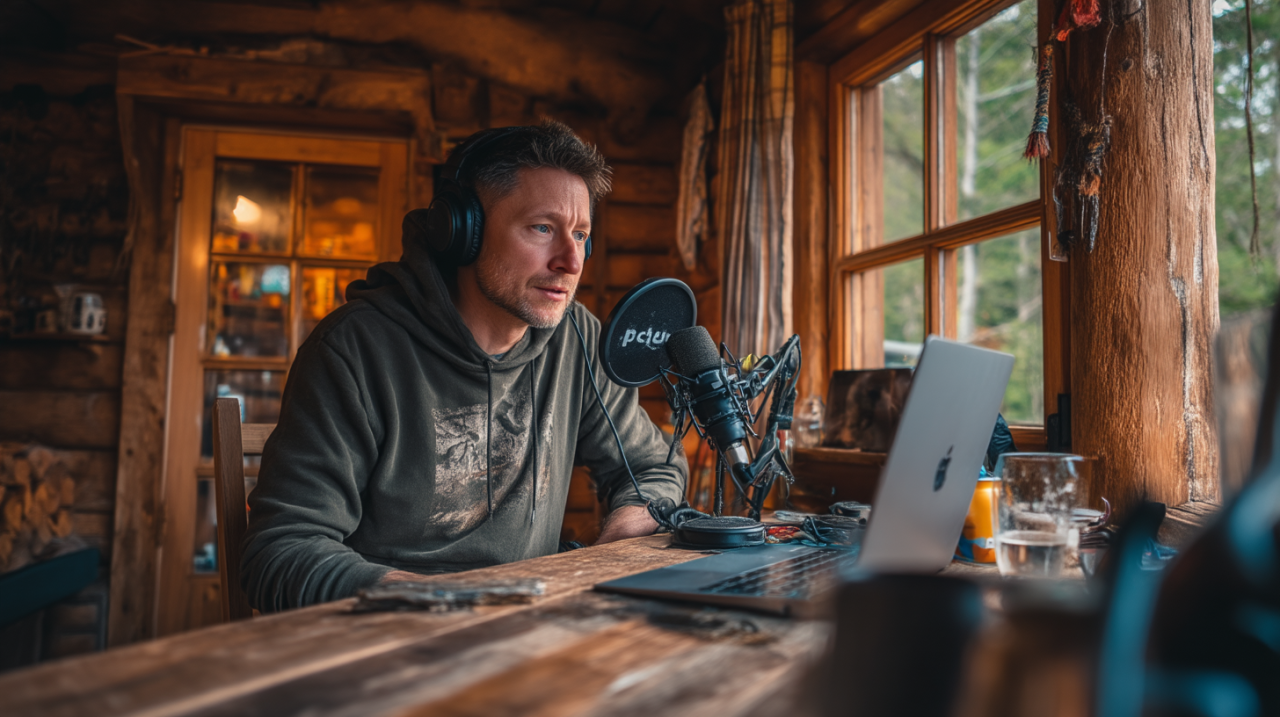Podcasting does not necessarily need to occur in a studio. More innovative men are now producing shows from non-traditional environments, such as vans, cabins, or Airbnbs, and defining their own audio domains. They're combining travel, narrative, and sound design to create episodes while in motion.
What this truly indicates is that podcasting is no longer location-specific. With a good mic, pocket recorder or laptop, and a good idea, they can capture real dialogue in forest cabins, beach vans or intimate Airbnbs.
Some of these producers adopt a richer timbre, even trying out a husky tone to bring presence in expansive open spaces. Dropping in that low end provides audio with a character that cuts through in echoey cabins or under rustling leaves. It's soft but impactful.
Continue reading to know how guys are building successful podcast shows on the road.
Beginning with purpose and agility
Here's the secret to podcasting on the road: planning.
You have a simple setup, which includes a mic, headphones, a recorder or laptop, and a rough idea of who you're interviewing and why. A traveling podcast host writes a five‑step plan for recording on the road: start with prioritizing planning guests, context, and sound quality before pressing record.
That prep becomes the foundation, whether you're cruising in a van conversion or cooped up in an Airbnb in a lake town.
The boundary isn't the problem; versatility is. These podcasters select equipment with portability and reliability in mind. Battery-powered or USB mics, pop filters, and portable power banks. Some augment Wi‑fi with extenders when uploading, particularly if cabins are off-grid. Amazon travel kit lists demonstrate that compact, rugged setups can get big sound anywhere.
Van-based studios
Van life podcasters tend to make their vehicle an extension of the storytelling. With a minimalistic, low-budget build, the interior is essentially a rolling booth—headphones and USB mics, solar panels for power, and cloth or barebones sound absorber lining the walls. Scenes change from beach pull-outs to forest campsites.
Consider Steven Richard of The Van Life Podcast. He records entire episodes from within his van conversion while on the road in America. He mentions having a roving podcast rig that is stable enough to use wherever—van, beach, roadside, you get it. That simple rig allows for an intimate space within and an unobtrusive exterior. It allows his storytelling to stay connected to place and cause—a blend of adventure and authenticity.
Why it works
Audiences listen for authenticity. A faint hum of a van behind the host, rain pattering on cabin shingles, or the faint rustle of Airbnb curtains conveys the place. That sense of place grounds stories in a way studio sound can't.
And there's flexibility. Pack up and leave. Configure just about anywhere. Answer guests in real time. Travelers and van-lifers tend to encounter interesting people, such as a hiker, a fellow traveler, or an Airbnb host, whose experiences wouldn't make it into a scripted studio show.
The environment is content itself. A cabin owner-host interviewing fellow builders becomes subject matter and setting at the same time. Talk about design, isolation, and building naturally comes with the cabin surroundings.
Practical difficulties and resolutions
- Noise is a nuisance. Wind, cars, wooden creaks. Many have a pop filter and windscreen on hand. They record during quiet times. They record indoors during bad weather. And they embrace the sounds of the outdoors - birds, water, background breeze - for perspective instead of quiet.
- Power and connectivity are important too. Some vans use solar panels or portable bases that can charge laptops for days. Cabins may require a generator or wi-fi boost. Numerous travelers bring a wi-fi booster to stream or upload in outlying areas.
- Backup is essential. Hosts tend to record onto SD cards and external hard drives. Episodes get uploaded after they arrive in areas with a good signal.
Tips for budding road podcasters
- Keep the podcast kit minimal and reliable. A good USB mic, headphones, and a recorder. Choose a gear that handles motion and outdoor use.
- Think about voice quality. A husky voice suits wide acoustic spaces. It carries and connects. Let your tone reflect the environment.
- Scout locations. Listen for echoes, background hum. Record a sample. Adjust the setup accordingly.
- Plan conversations. Know who you’re interviewing and why.
- Control power and upload access. Pack portable power supplies. Back up files redundantly. Employ wi‑fi boosters if necessary.
- Embrace ambient sound. Crackling fire or wind in pine gives character. Employ it, don't resist it.
- Be there. Sometimes, set aside the constant recording. Think later and interview others subsequently.
Final Thoughts
Podcasting from vans, cabins, and Airbnb has flipped the script. It has made audio making mobile, location-based, and unfiltered. The content mirrors the surroundings, and the surroundings become part of the program. There's more narrative, less gloss. More realness, less production gloss.
Listeners feel closer. They smell the woods. They go along in the van. They have tea with the host deep in a cabin. That is intimacy that can't be engineered behind studio walls.
In short, guys creating podcasts out of vans, Airbnbs, or cabins defy the rules and discover something richer in the process. Equipment does not have to weigh a ton. Schedules do not have to be set in stone. Honest voices and a sense of location carry every show.
